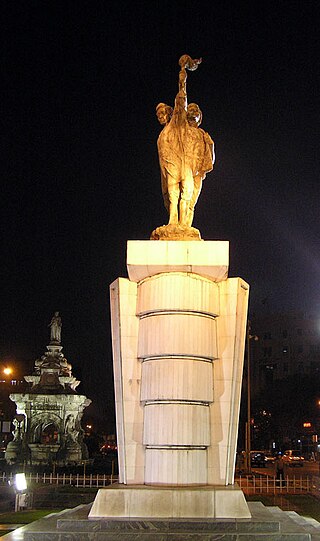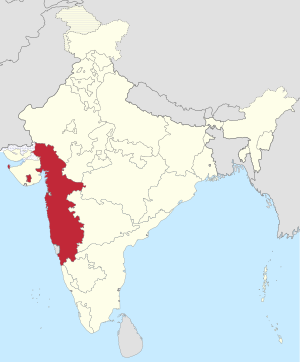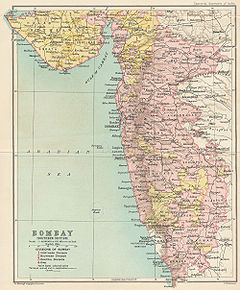
Maharashtra is a state in the western peninsular region of India occupying a substantial portion of the Deccan Plateau. It is bordered by the Arabian Sea to the west, the Indian states of Karnataka and Goa to the south, Telangana to the southeast and Chhattisgarh to the east, Gujarat and Madhya Pradesh to the north, and the Indian union territory of Dadra and Nagar Haveli and Daman and Diu to the northwest. Maharashtra is the second-most populous state in India and the fourth-most populous country subdivision globally.

India is a federal republic comprising 28 states and 8 union territories. The states and union territories are further subdivided into districts and smaller administrative divisions.

Samyukta Maharashtra Movement, commonly known as the Samiti, was an organisation in India that advocated for a separate Marathi-speaking state in Western India and Central India from 1956 to 1960.

The Bombay Presidency or Bombay Province, also called Bombay and Sind (1843–1936), was an administrative subdivision (province) of British India and later the Dominion of India, with its capital in the city that came up over the seven islands of Bombay. The first mainland territory was acquired in the Konkan region with the Treaty of Bassein (1802). Poona was the summer capital.

Western India is a loosely defined region of India consisting of western states of Republic of India. The Ministry of Home Affairs in its Western Zonal Council Administrative division includes the states of Goa, Gujarat, and Maharashtra along with the Union territory of Dadra and Nagar Haveli and Daman and Diu, while the Ministry of Culture and some historians also include the state of Rajasthan. The Geological Survey of India includes Maharashtra but excludes Rajasthan whereas Ministry of Minority Affairs includes Karnataka but excludes Rajasthan.
The Marathi people or Marathis are an Indo-Aryan ethnolinguistic group who are indigenous to Maharashtra in western India. They natively speak Marathi, an Indo-Aryan language. Maharashtra was formed as a Marathi-speaking state of India in 1960, as part of a nationwide linguistic reorganisation of the Indian states. The term "Maratha" is generally used by historians to refer to all Marathi-speaking peoples, irrespective of their caste; however, now it may refer to a Maharashtrian caste known as the Maratha.

Maharashtra Day, commonly known as Maharashtra Din is a state holiday in the Indian state of Maharashtra, commemorating the formation of the state of Maharashtra in India. from the division of the Bombay State on 1 May 1960. Maharashtra Day is commonly associated with parades and political speeches and ceremonies, in addition to various other public and private events celebrating the history and traditions of Maharashtra. It is celebrated to commemorate the creation of a Marathi speaking state of Maharashtra.
The States Reorganisation Commission (SRC) constituted by the Central Government of India in December 1953 to recommend the reorganization of state boundaries. In September 1955, after two years of study, the Commission, comprising Justice Fazal Ali, K. M. Panikkar and H. N. Kunzru, submitted its report. The commission's recommendations were accepted with some modifications and implemented in the States Reorganisation Act in November, 1956. The act provided that India's state boundaries should be reorganized to form 14 states and 6 centrally administered territories. On December 10, 1948, the report of Dar Commission was published but the issue remained unsolved.
Mumbai, also known as Bombay, is the financial capital of India and one of the most populous cities in the world. Mumbai grew into a leading commercial center of India during the 19th century on the basis of textile mills and overseas trade. After independence, the desire to domesticate a Marathi social and linguistic Mumbai to a cosmopolitan framework was strongly expressed in the 1950s. Mumbai, one of the earliest cities in India to be industrialized, emerged as the centre of strong organized labour movement in India, which inspired labour movements across India.
Keshavrao Marutirao Jedhe (Deshmukh) (21 April 1896 – 12 November 1959) was an Indian independence activist and politician from Pune. He served as a leading figure in the Indian National Congress, and in the Samyukta Maharashtra movement during the independence. The famous Swargate chowk in Pune is named after him.

The Vidarbha movement includes political activities organised by various individuals, organizations and political parties, for creation of a separate state of Vidarbha, within the republic of India, with Nagpur as the capital. The proposed state corresponds to the eastern 11 districts of the state of Maharashtra. It makes up for 31% of area and 21% of population of the present state of Maharashtra. The area is covered by thick tropical forests and is surplus in electricity, minerals, rice and cotton.
Jan 28, 1940: The Samyukta Mahasabha organization is formed in Bombay to pursue the resolution passed at the literary meet.

Kutch State was a state within India from 1947 to 1956. Its capital was Bhuj.

Saurashtra State, formally known as United States of Kathiawar and later United States of Saurashtra, was a State of India that existed between 1948 and 1956, on Saurashtra alias Kathiawar peninsula, with Rajkot as its capital,

Maharashtra is a state in the western region of India. It is India's second-most populous state and third-largest state by area. The region that comprises the state has a long history dating back to approximately 1300–700 BCE, although the present-day state was not established until 1960 CE.

Mahagujarat movement, known locally as Mahagujarat Andolan, was a political movement demanding the creation of the state of Gujarat for Gujarati-speaking people from the bilingual Bombay state of India in 1956. It succeeded in the formation of Gujarat on 1 May 1960.

The States Reorganisation Act, 1956 was a major reform of the boundaries of India's states and territories, organising them along linguistic lines.
















